Slices are flexible and efficient, but their implementation has some quirky behaviours, leading to unexpected results.
Let us see how they really work and how to avoid running into problems.
Understanding slices
A couple of days ago, this answer appeared on my X feed:
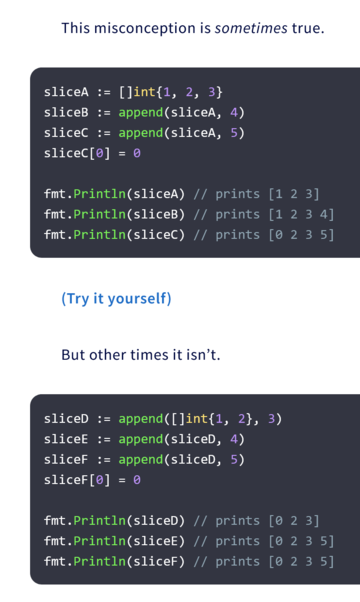 https://x.com/likely_a_DFS/status/1793399293312966777
https://x.com/likely_a_DFS/status/1793399293312966777
It made me wonder whether the internal operation of slices is actually well known by many Go developers, especially beginners. I figured that would make for an interesting explanation, so here we go, line by line.
What’s in a slice, really ?
The actual runtime implementation of slices lives in runtime/slice.go :
| |
The runtime also defines a runtime.notInHeapSlice similar type,
for limited use cases outside the control of the garbage collector.
These two equivalent types, both of which represent slices at run time,
carry no method, and are hence just plain three-field structs :
- a pointer, either using the public
unsafe.Pointertype, or the runtime-internalnotInHeaptype len: the slice length as elements, not bytescap: the slice capacity as elements too. It is always larger than or equal tolen.
The expected
We will be going through that code fragment, one statement at a time,
and see how the memory allocation changes with each instruction.
The explanation is taken from both tracing the runtime code and
checking the generated assembly code on Go 1.22.4 for arm64, amd64, wasm, loong64, and ibm390 for consistency.
Create a slice from a literal
sliceA := []int{1, 2, 3}
- builds the slice manually at compile time:
- allocates an object:
runtime.newobject(typ)- where
typ.Size == 24andtyp.Kind_ == abi.Array - so this is an
arrayfor 24 bytes = 3 64-bit integers,
- initializes a
runtime.slicestructure as :- the allocated result, for the
array unsafe.Pointerfield len == 3cap == 3- and the 3 literal integers 1, 2, and 3
- the allocated result, for the
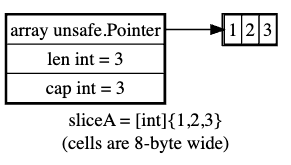
Append a single element to a full slice
Our sliceA is full, meaning its len equals its cap.
We create sliceB by appending a single int to sliceA :
sliceB := append(sliceA, 4)
- grows the slice invoking
runtime.growslicewitholdPtrfrom the existing slice pointernewLen == 4because we append one valueoldCap == 3which is the current slice capacitynum == 1which is the number of elements being appended
- internally,
growslice- invokes
runtime.nextslicecapto get the capacity the appended slice needs, getting twice the existing capacity because our slice is small enough - does some checks and concludes that the proper
newCapis indeed 6 64-bits integers, hence 48 bytes - accordingly, allocates a new 48 bytes space
- clears the part of that space that will not be copied over from the old slice using
runtime.memclrNoHeapPointers - copies the values in the old array to the new space using
runtime.memmove - returns a new
runtime.sliceinstance allocated from that new space, the receivednewLenand adjustednewCap.
- invokes
sliceBis full too, andsliceAis unchanged.
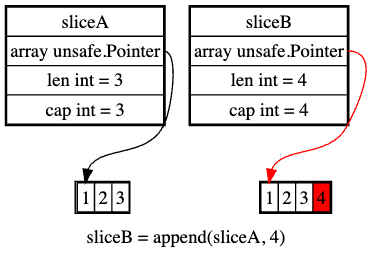
Append a single element to a full slice - again
If we do it again to add a different element to sliceA, the same mechanism happens :
sliceC := append(sliceA, 5)
- goes through the same motions, allocating a new space for the slice array too
sliceCis full too, andsliceAis still unchanged.
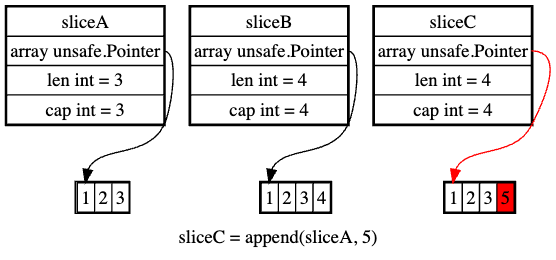
Update an element in the append-ed slice
sliceC[0] = 0
- modifies the first
intin the (new) array backingsliceC - because that array is not shared, nothing happens to
sliceAandsliceB.
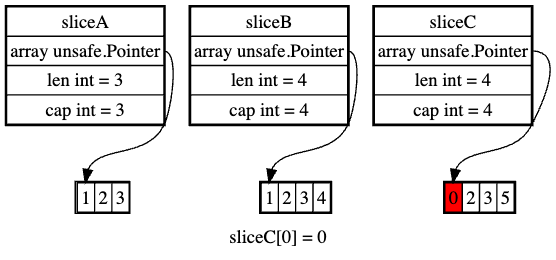
Which gives us the first set of results, which pretty much any developer would expect.
| |
The unexpected
For the second set, the results are a bit different because of the way the initialization is performed.
Create a slice by appending an element to a slice literal
This time, instead of using a three-element slice literal, we will initialize our slice by appending an element to a two-element slice literal instead.
sliceD := append([]int{1, 2}, 3)
- builds the
[]int{1, 2}slice manually at compile time, following the same steps as the one initializingsliceA - at this point, the slice has
cap == len == 2 - now the append happens the same way it did to build
sliceBandsliceC, resulting in slice[]int{1, 2, 3}now having a double-size backing array, hence 4 bytes, not just three likesliceAdid
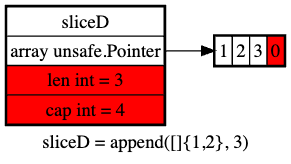
Append a single element to a non-full slice
Our sliceD is not full, meaning its len is strictly less that its cap (3 vs 4).
We create sliceE by appending a single int to sliceD :
sliceE := append(sliceD, 4)
- here, however, the compiler is smart enough to generate code checking whether the size of the backing array in
sliceDis less than 4 before invokinggrowslice - because the array is actually of size 4, that call is omitted and the existing array is reused, code only setting the value 4 in the last position of that array
- the new slice reuses that array as its backing store
sliceDandsliceEare now sharing that same array with contents[1 2 3 4]
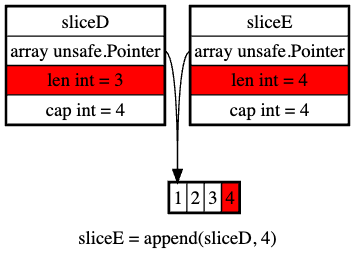
Append a single element to a non-full slice - again
If we do it again to add a different element to sliceD, the same mechanism happens :
sliceF := append(sliceD, 5)
- the same compiler check again notices that the backing array has length 4, so a call to
growsliceis not needed either - the new slice reuses that array as its backing store, just like
sliceDandsliceE - code then sets the value 4 in the last position of that array to 5, meaning all three slices are backed with array
[1 2 3 5]
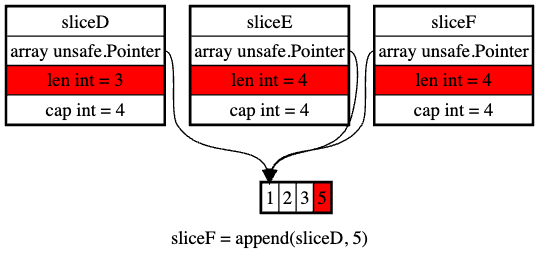
Update an element in the append-ed slice
sliceF[0] = 0
- because this is just an in-place update, the code sets position 0 in the array backing
sliceF, making it contain[0 2 3 5] - but because that array is also the backing store for
sliceDandsliceEthey also get that same update.
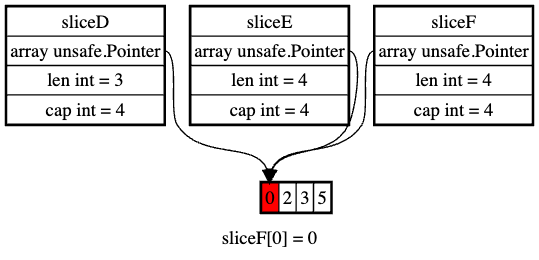
And that is how we get these possibly surprising results:
| |
The cautious ways
The slices.Clip function
Now, if you do not want to care about what is really going on, and prefer having a little bit of extra work done by your code, there are solutions, and one of those is mentioned by the author of the initial post:
 https://x.com/likely_a_DFS/status/1793629501911609691
https://x.com/likely_a_DFS/status/1793629501911609691
So, how does slices.Clip work around this problem, exactly ?
As its documentation says, Clip removes unused capacity from the slice
.
In this example, our problem stems from the fact that we initialized sliceD with some extra capacity,
thus allowing the subsequent append() calls to reuse the backing array for sliceD unchanged.

Now, we could either have avoided that extra capacity by building the slice like we did for sliceA. But sometimes, we have to extend slices we receive and do not control their prexisting backing
array.
In such a case, we could write something like
| |
Now, with that extra slices.Clip call, our memory model changes:
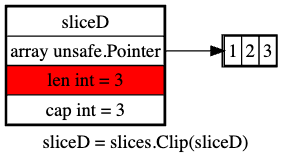
And with that we are back at the exact same situation as we had for sliceA and we get the expected results:
sliceD, sliceE, and sliceF all have independent backing arrays.
The “full slice expression”
Now, could we have done without that extra function call ,
especially considering that slices.Clip uses generics ?
See, slices.Clip is actually a tiny function. As it currently exists in Go 1.22.4:
| |
That slicing syntax with two colons is what the Go spec call a full slice expression . It performs both slicing and truncation of the backing array.
So we could just as well have written our clipping ourselves:
| |
And that’s it: no extra import, no generic function call.
But since that complete form of the slicing operator appears to be so little known among Go developers,
using the slices.Clip function may be a better choice for code readability.